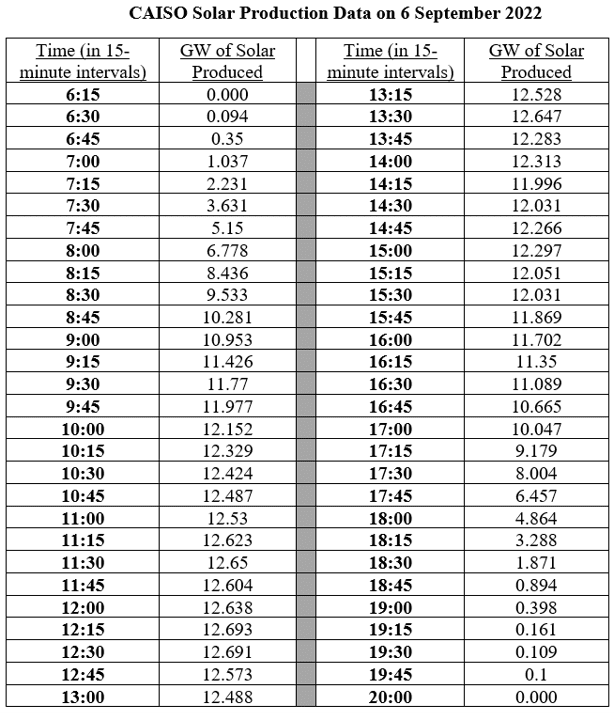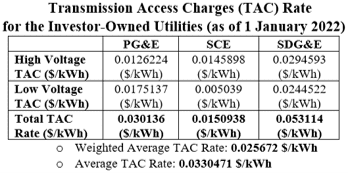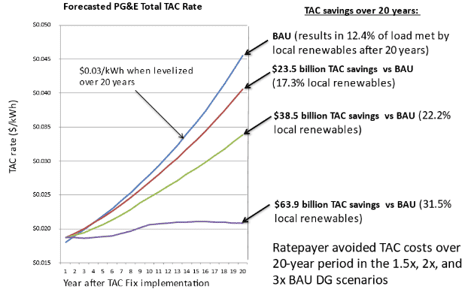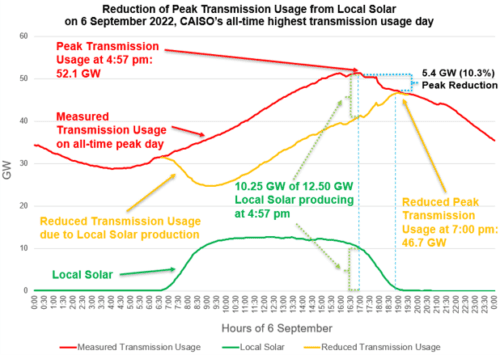
Local solar is the best solution for reducing peak transmission usage and electricity costs for ratepayers
In a blog post written by the Clean Coalition, we explain why local solar is poised to save ratepayers hundreds of billions of dollars in avoided transmission costs.
Local solar is the best solution for reducing peak transmission usage and electricity costs for ratepayers
In early September, a scorching heat wave swept through the Western United States, breaking nearly 1,000 heat records in different areas! Scientists would go on to describe it as the hottest and most severe September heat wave on record in the region. On each day of the 10-day heatwave, millions of Californians cranked air conditioning from mid-morning through late evening. The result: an unprecedented strain on the electric grid during the long-standing 4-9pm periods of peak transmission usage. This chart (below) shows how air conditioning increased electricity demand on 6 September 2022, the day that set a new all-time record for peak transmission usage, happening at 4:57pm according to the California Independent System Operator (CAISO):
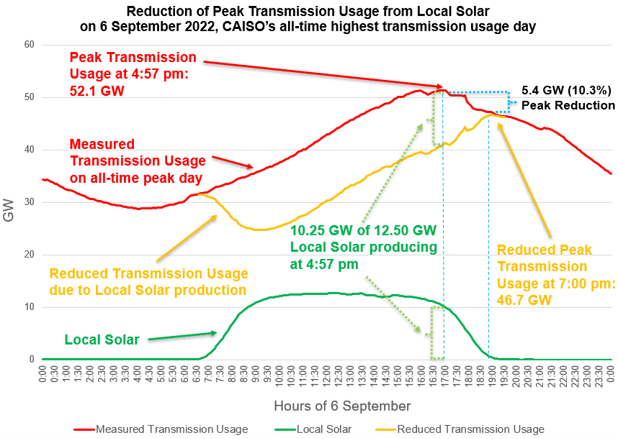
Local solar is the most effective way to reduce peak transmission usage, and in eliminating transmission costs as the biggest factor increasing electricity prices. This graphic shows that if the 12.5 GW of transmission-interconnected solar recorded by CAISO on 6 September 2022 had come from local solar, the peak transmission usage on that all-time historic-peak day would have been reduced by over 10%. Hence, local solar would have had a nearly 5 times greater impact in reducing peak transmission usage than the record-setting 1.2 GW of Demand Response on that day. Given that peak transmission usage is the primary cause of new transmission investments, local solar is poised to save ratepayers hundreds of billions of dollars in avoided transmission costs. Importantly, the benefits of local solar increase exponentially when paired with local energy storage, including via export capabilities coming to Electric Vehicles (EVs).
This CAISO table (below) shows the time that transmission usage peaked in each year since CAISO began operating California’s transmission grid in 1998, showing the new all-time peak of 52,061 MW occurring at 4:57pm on 6 September 2022:

Interestingly, the prior peak transmission usage record of 50,270 MW had occurred in 2006. The long duration between these peaks is indicative that local solar has already preempted hundreds of billions of dollars in transmission cost obligations that would have otherwise been heaped on California ratepayers.
Based on historical usage patterns and trends, CAISO (and everyone else) should be able to clearly see that peak transmission usage would occur around 5pm during the recent heat wave in early-September, as people come home from work and crank their air conditioning, in addition to their normal evening activities. Equally predictable is the fact that local solar reduces peak transmission usage and saves ratepayers unparalleled levels of transmission costs, which are the fastest growing component of electricity bills. Local Solar reduces Peak Transmission Usage by almost 50% of the total generating capacity of the Local Solar (see CAISO solar production data for 6 Sep 2022 at the bottom of the article – Appendix A).
On the other hand, it is worth being crystal clear that remote generation of any flavor that is dependent on the transmission grid does not reduce transmission usage. For a clear example, here is a chart showing the remote solar provided no reduction to the peak transmission usage on 6 September 2022 – the same as on any other day, because remote solar inherently depends on the transmission grid to get delivered to where electricity is needed, which is where people live and work:
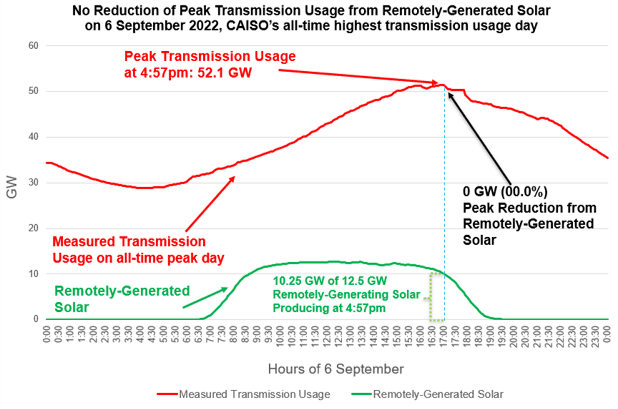
Although retail electricity rates are always high in the 4-9pm period every day, retail rates do not accurately reflect how exorbitant peak transmission usage is to ratepayers. For a clear example, during the peak transmission usage afternoon on 6 September, the wholesale price of electricity spiked to an astronomical level, hundreds of times higher than normal, as shown in the chart below. Importantly, these excessive wholesale costs subsequently caused increases to retail rates and help explain the vicious cycle that can be preempted by local solar.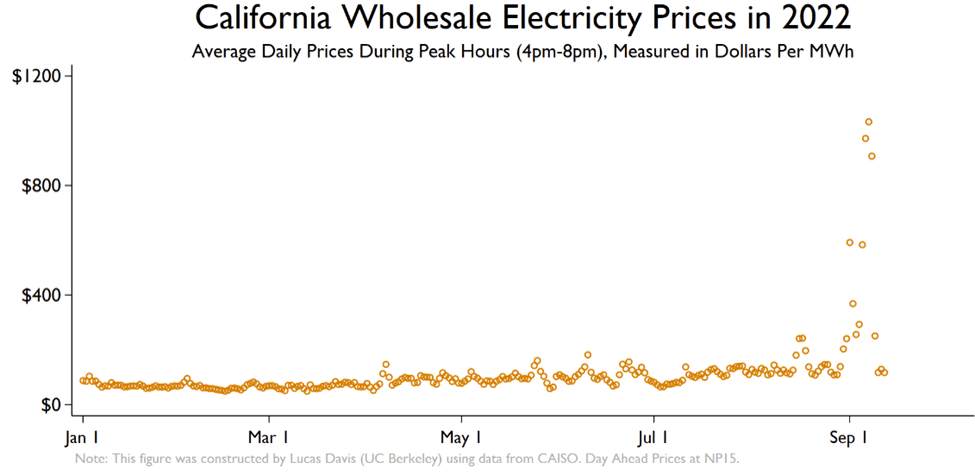
Normal wholesale electricity prices, which are based on the cost of a MWh of energy from a transmission-interconnected resource, only reflect a small portion of the actual transmission usage costs, which are mostly comprised of Transmission Access Charges in California and total an average of about 3 cents/kWh today – and are growing faster than any other component of electricity costs. The additional components of transmission usage that are captured in wholesale prices of electricity are associated with line losses and congestion costs, and while line losses consume an average of about 10% of electricity that uses the transmission grid, the inefficiencies are far higher during peak peak transmission usage periods when high temperatures exacerbate line losses and congestion constraints require circuitous routing to deliver energy over the transmission grid – or require the purchase of energy from much higher cost sources that would typically be too uncompetitive to run (and usually too dirty as well). Hence, the benefits of local solar go way beyond just looking at the average costs associated with transmission usage.
Additionally, it is important to consider energy resilience, and long supply lines are inherently not resilient – just ask Texas, Florida, North Carolina, and Puerto Rico for recent examples. A transmission-centric energy system is based on a hundred-year-old design that generates energy remotely and is dependent on long transmission lines to reach the places where energy is actually needed, where people live and work. Everywhere else, California needs an energy system that is efficient, flexible, and resilient; given the dangers posed by climate change and the need to achieve a net zero energy economy.
The record level of demand in early September is indicative of the increasing strain being placed on the transmission grid as the climate continues to warm and we strive to achieve clean energy and electrification goals. Based on the most recent Scoping Plan released by the California Air Resources Board (CARB), total energy demand is set to increase by 68% as the state fully decarbonizes and achieves full building/transportation electrification. We need to think about how to optimize the electricity system and invest effectively in order to make the cost of electricity more affordable for the ratepayers. The question is how?
The electricity system needs to be optimized for the trifecta of economic, environmental, and resilience benefits.
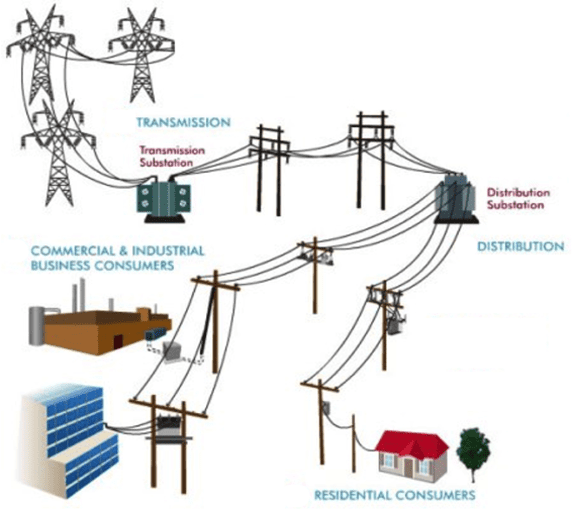
The solution is to deploy a higher penetration of local resources, including microgrids, and non-wires alternatives (any electrical grid investments that minimize, defer, and/or eliminate transmission & distribution infrastructure investments), rather than simply adding new remote energy generation – of any flavor – that requires new transmission investments in response to increasing electricity demand. The existing grid is based on erroneous assumptions around the cost-effectiveness (and reliability) of having remote generation travel over inefficient long transmission lines that then shift the energy down to lower voltages at transmission-distribution substations, before finally delivering energy to end-users over via the distribution grid
This method, called Transmission Energy Downflow (TED), is the reason that the entire energy system is overbuilt – the grid is designed to handle peak conditions through adding incremental transmission infrastructure and new-remote resources. In other words, the grid is built for just one month, September, each year.
However, this 20th century mentality does not consider that remote generation is inherently inefficient and non-resilient because of the massive transmission system required to deliver energy to end-users. In contrast, local resources (also called distributed generation resources) are interconnected – and the energy is consumed – locally, on the distribution grid.
Each kWh of distributed generation reduces the need for remote-generated resources that require the transmission system, lessening the amount of line congestion, reducing line losses, and enabling normal market outcomes to occur. This is known as the value of avoided transmission. And unlike remote generation, distributed generation benefits the broader community by readying the local distribution grid for resilience through the deployment of a Community Microgrid.
To demonstrate the value that distributed generation creates by reducing Peak Transmission Usage, let’s consider the hypothetical situation mentioned above (based on actual system demand data from 6 September 2022). The first scenario, below, demonstrates what the effect would have been if the 12.5 GW of transmission-interconnected solar were instead produced by local solar (interconnected to the distribution grid).

The actual system peak, 52.1 GW, occurred at 4:57pm on 6 September. By that point in the day, solar production had started to wane, but panels were still producing at about 80% of the maximum daily efficiency, generating 10.25 GW. The effect of local solar production is denoted by the yellow line, which shows New Transmission Usage (or, the Peak Transmission Usage minus Local Solar production). Even as solar production wanes to zero over the last two hours of daylight, the amount of energy produced is enough to significantly reduce peak transmission usage, by 5.4 GW, or 10.3%. The peak reduction caused by local solar production would have eclipsed the actual value provided by energy storage and the demand response event combined.
On 6 September, local solar production would have reduced peak transmission usage by 5.4 GW (10.3%).
On the other hand, the graph below shows the normal production curves of Remotely-Generated Solar. Notice that there is no New Transmission Usage curve. Why? Regardless of increasing transmission system usage, Remotely-Generated Solar still requires the use of transmission infrastructure to be delivered to the end user.

As a result, there is zero peak reduction and the peak TED stays the same. Increasing the amount of Remotely-Generated Solar only adds to peak congestion and offers the same amount of Peak Transmission Usage reduction as any other flavor of remote generation (i.e., zero). On the other hand, there is a clear and tangible benefit from installing more local solar.
The transmission-elephant in the room.
The last piece of the puzzle is the financial conflict of interest that exists when it comes to the utilities and building new transmission infrastructure. The Investor-Owned Utilities (IOUs) are granted cost recovery on all ongoing transmission spending (OpEx and O&M costs) by the Federal Energy Regulatory Commission (FERC) as well as a set rate of return of between 9% and 12% on all capital costs (CapEx costs plus depreciation). Transmission assets last for 40-50 years, making every investment in transmission infrastructure a guaranteed cash cow for the IOUs. In comparison, these investments are not nearly as cost-effective for the average Californian. For every dollar spent as an upfront capital expenditure on a transmission project, over the lifetime of the transmission asset, the ratepayers end up footing a bill that is 10x that amount in nominal dollars. See the linked Utility Dive article, which underscores the value that California can capture through mandating that the IOUs divest their transmission assets and focus on investing in local renewables.
In addition to changing the grid planning process to promote deployments of local renewables, all resources must be able to operate on a level playing field in order to effectively transition to the optimal grid of the future. Currently, the IOUs recover the cost for historical transmission investments – through Transmission Access Charges (TAC) – from all ratepayers at the customer meter. As a result, all energy supplied by the grid is charged for usage of the transmission grid, regardless of where it originates. Energy transmitted from a hydro-electric dam in the Pacific Northwest is charged exactly the same amount of TAC as a rooftop solar project in San Francisco where all exported energy on the local distribution feeder. The resulting market distortion incorrectly skews the market toward the view that remote generation is more cost-effective than local resources.
The Clean Coalition has designed a simple solution to the TAC market distortion that is based on the fundamental principle of Transmission Energy Downflow. As shown in the image above, rather than assessing TAC at the customer meter, switching to the way TAC is allocated by metering it at the Transmission-Distribution (T-D) substation will level the playing field. Importantly, the municipal utilities already meter TAC correctly, so the fix will not be difficult to implement. Ensuring that TAC is assessed properly at the T-D substation will ensure that all energy that uses the transmission system will be assessed TAC – and all energy that never touches the transmission system will NOT be charged a TAC fee.
The TAC fix will realign the market, promoting investment in distributed generation and deployments based on the maximum value a resource provides to the community and the broader grid. Over the next couple decades, as the state transitions to a net zero society, increasing the number of installed local renewables – which reduce Peak Transmission Usage – will result in significant ratepayer savings and help make electric rates more affordable for all. Local renewables will also provide much-needed energy resilience as this critical grid safety need grows, while helping satisfy the projected electrical load growth caused by our decarbonization efforts.
Appendix A:
